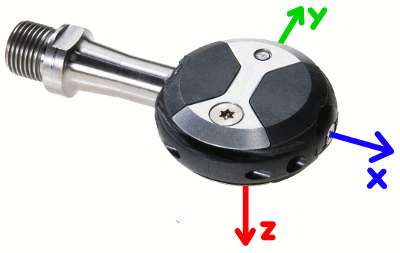Metrigear Vector Pt 6: Forces and Bending (3)
The previous analysis described how local curviture of the pedal spindle might be used to extract out moments of force applied to the body: the total downward force and the twisting torque. The sensors would measure the distortion of the pedal spindle, which with an appropriate calibration factor, would yield the values of the bending moment, from which the force and torque on the pedal body can be derived. Of course, this is total speculation on my part, as I really do not know how the Vector really works: it is just a plausibility argument that (1) the problem is non-trivial, and (2) the solution may be tractible.
Given the coordinate axes defined for the pedals (right pedal shown here):

Axes for right pedal
it is clear that this analysis applies to the force in the y and z directions, and to torques applied about these axes. For a force in the x direction, the spindle does not bend, but rather stretches. In this direction, it should behave like a linear spring: fractional stretch in proportion to the applied force. This could be directly measured with a strain sensor in the spindle, with the associated spring constant calibrated after assembly.
For the associated torque, associated with the spindle being twisted, additional sensors could be used, again calibrated to the mechanical properties of the spindle. As I noted early, the derived twisting torque, when multiplied by the rate of pedal rotation, would indicate the amount of power being lost in the pedal bearings. Even if this is an insignificant fraction of total power, it could be an indication of the need to service a pedal, for example.
So, to get the full set of three forces (for example, x, y, and z) and three torques (for example about these three axes) applied to a pedal one needs:
Parameters which require calibration include:
In addition to these calibration factors, since the piezoelectric effect has a strong temperature coefficient, a temperature sensor is needed to compensate for this.
So that's it: enough on forces! I could be completely off base, and Metrigear does things completely different. But at least to the extent of my freshman physics simplicity, I think I've made my plausibility argument that the thing may actually work.
The next issue is how to use this force information to generate power. That's where the accelerometers come in.
Given the coordinate axes defined for the pedals (right pedal shown here):

Axes for right pedal
it is clear that this analysis applies to the force in the y and z directions, and to torques applied about these axes. For a force in the x direction, the spindle does not bend, but rather stretches. In this direction, it should behave like a linear spring: fractional stretch in proportion to the applied force. This could be directly measured with a strain sensor in the spindle, with the associated spring constant calibrated after assembly.
For the associated torque, associated with the spindle being twisted, additional sensors could be used, again calibrated to the mechanical properties of the spindle. As I noted early, the derived twisting torque, when multiplied by the rate of pedal rotation, would indicate the amount of power being lost in the pedal bearings. Even if this is an insignificant fraction of total power, it could be an indication of the need to service a pedal, for example.
So, to get the full set of three forces (for example, x, y, and z) and three torques (for example about these three axes) applied to a pedal one needs:
- two measurements along the spindle along each of two orthogonal axes of the bending of the spindle,
- a measurement of the stretch of the spindle,
- a measurement of the twist distortion of the spindle.
Parameters which require calibration include:
- the stiffness of the spindle to bending at each of the two points, yielding the proportionality factor relating spindle curvature to bending moment (torque), perhaps separately along each of the two orthogonal axes,
- the spring constant assocated with elongation of the spindle,
- the spring constant assocated with twisting the spindle.
- For extra accuracy, the mass of the pedal body and the portion of the spindle from the center of the sensors outward, to calculate the power going into changing the rotation rate of these mass components. This kinetic energy component is directly between the shoe and the pedal, not transmitted through the pedal spindle, and therefore wouldn't otherwise be measured by Vector.
In addition to these calibration factors, since the piezoelectric effect has a strong temperature coefficient, a temperature sensor is needed to compensate for this.
So that's it: enough on forces! I could be completely off base, and Metrigear does things completely different. But at least to the extent of my freshman physics simplicity, I think I've made my plausibility argument that the thing may actually work.
The next issue is how to use this force information to generate power. That's where the accelerometers come in.

Comments